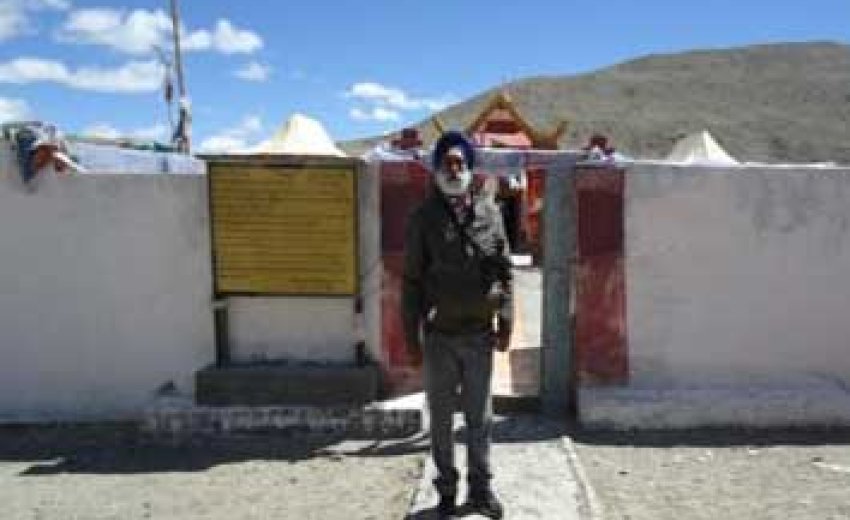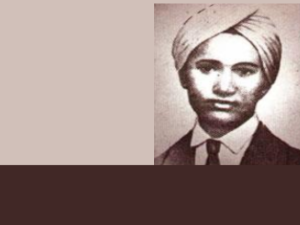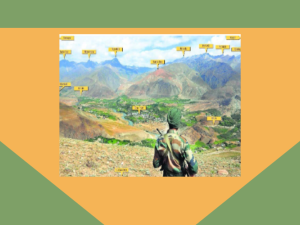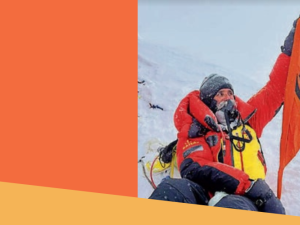A team consisting of Dr Dalvinder Singh Grewal, S. Harbhajan Singh Setia and his son Gurwinder Singh Setia industrialists from Delhi, Dy CE SPS Grewal, Er. Jaspal Singh and Principal Gurcharan Kaur from Ludhiana and Tejwant Singh of Aaj Tak from Amritsar visited Gangtok, Chungthang, Guru Dongmar and Dhubri from 01 May to 8 May 2015. Some members of the team have been connected with these institutions since 1970.
Col Dr Grewal was posted as an Army Officer in Sikkim as Lt. in 1970-1971 and Lt Col from 1987-1992 and was involved in construction and development of these Gurdwaras and having written three books and numerous articles on Guru Nanak after detailed research and regular visits to these places. S Harbhajan Singh Setia, now 84 years old, has been regularly visiting the place since 1992 and has been watching and reporting the gradual conversion.
The team got a shock when it found no Gurdwara or Nishan Sahib at Gurdwara Gurudongmar Sahib. Instead it found it converted into a Budhist complex now. Similarly at Lachen Gompha Guru Nanak's robe (chola sahib) footprints and vessel (kamandal) were not being shown to visiting Sikhs since last three years. These were regularly shown earlier. At Chungthang the main complex connected with Guru Nanak including the stone, fountain and footprints of Guru Nanak and the rice fields are now barricated from Gurdwara and the complex is being controlled by Lepcha Lamas. A huge tower is constructed close to the Gurdwara affecting its sanctity.
The ground reality as compared with the past knowledge of the team is presented here with the help of videos and photographs and the historical facts as available in the texts.
Historical Records show that during his journeys to the Himalayas and the Far East, including China, Guru Nanak visited all these states around 1516 AD. This itinerary is found recorded in Janam Sakhi Bhai Bala; Janam Sakhi, Walait Wali; Janam Sakhee Meharban; Janam Sakhee B-40; Suchak Parsang by Bhai Behlo; Mahima Parkash by Baba Sarup Chand; Parchian Sewa Das; Nanak Prakash by Bhai Santokh Singh; Nanak Parkash, Twarikh Guru Khalsa and Gurdham Prakash by Gyani Gian Singh; Guru Khalsa Twareekh by Giani Lal Singh (Sangrur); Jeevan Charit Guru Nanak Dev ji by Dr. Trilochan Singh; Travels of Guru Nanak by Dr. Surinder Singh (Kohli); Atlas of Travels of Guru Nanak by Dr Fauja Singh and Kirpal Singh; Guru Nanak's Travels to Himalayan and East Asian Region, Amazing Travels of Guru Nanak, So Than Suhawa and Van Suwane by Dr. Dalvinder Singh (Grewal) (the author), and a host of other researchers. Though Janamsakhis and other contemporary material are vague about the names of the places, yet they are specific about Al-Lachen and Bhutan Des which are specially mentioned in these Janamsakhis.
As per historical records Guru Nanak travelled to North during his third udasi [1]. He visited Sumer [2] Nepal [3] Tibet [4] Sikkim [5] Bhutan [6] Arunachal Pradesh [7] Burma and China [8]. In Sikkim, he visited Lachen [9] Chungthang [10] Thanggu [11] and Gurudongmar [12] among other places. Gurdwaras were constructed in Nepal [13], Chungthang [14], Gurudongmar [15] and Menchukha [16] to commemorate his visit to these places.
Record of visit of Guru Nanak to Sumer in Tibet by Bhai Gurdas (1551-1636 AD) [2] and to Sikkim by Giani Gian Singh (1824-1884 A.D) are some of the oldest records found so far. [5]
Guru Nanak visited the place in 1516 A.D. His visit to Kanchanjunga Hill area is found recorded by Giani Gian Singh. 'uthon age (from Nepal) Sikkim des Tamlang Shehar jo uthon di rajdhani si usde uttar vani ik pahadi par ja baithe…ethon Darjeeling, chungathan nun dekh kanchan (kanchanjunga) parbat nun langh anek bastian pahadan da jhaka lai Bhutan des vich parves keeta.' "Next (from Nepal) he moved to Tamlang the then capital of Sikkim and sat in the hills in the north. Having seen Darjiling and Chungthan he crossed over to Kanchanjunga hills complex (Gurudongmar is within the Kanchanjunga hill complex and viewing many settlements and hills, he entered Bhutan.) (Giani Gian Singh Giani) (p. 215) Twareekh Guru Khalsa, 1880 [5] In the plateau close to Kanchenjunga the yak graziers approached Guru Nanak with a request, that: "they do not find water in winter as it gets frozen all over, temperature falling down to minus 35 degrees. He hit the frozen lake by the side of Kanchanjanga [17] with his stick which he always carried during his journeys.[18] Lo! The ice broke never to be frozen again displaying crystal clear water. Since then the water of the lake is stated to never freeze.
The lake and the hill feature atop have come to be known as Gurudongmar Lake and hill respectively. The same names are found recorded in the ancient maps prepared by the British in nineteenth century. Some grazers projected another problem to Guru Nanak. Due to the effect of altitude, their virility was affected. They requested the Guru to do something about it. Guru Nanak blessed the lake, saying, "Whosoever takes the water of this lake will gain virility and strength and will be blessed with children." The people of the area have firm faith in Guru's words and consider the water of the lake as nectar. A Gurdwara was constructed in the eighties to commemorate Guru Nanak's visit to the place. We used to trek to Gurudongmar then, after travelling from Chungthang on foot, covering the distance in six days. The local people of the area and Lamas of Karma-pa Nying-ma-pa Sect confirm Guru Nanak's visit to these areas. The Lamas from these areas have been visiting Golden Temple, Amritsar, regularly to pay obeisance to their beloved Guru Rimpoche, Guru Nanak, also known as 'Nanak Lama in their areas.[15] A board earlier displayed near the Gurdwra narrated this all.
His contact with Siddhas and Lamas has also been recorded by Giani Gian Singh [5] who wrote: "Crossing the great river which branches into Brahmputra and Kosi, Guru Nanak went into the land of Lamas. This area is between China, Tibet and Kailash and populated by Buddhists. They worship Guru Nanak like God.' (p.217) Bhai Vir Singh [19] wrote 'There are four gomphas on the four sides of Mansarovar, which have idols of Guru Nanak along with Buddha and other saints.' (p.141) Bhai Didar Singh who stayed in Simla and Tibet area spoke to him, "In the Tibet border and Gartok, signs of Guru Nanak's visit to Tibet, propagating Naam and giving life to people are found. In Tibet two types of Lamas live (a) The followers of Mahatma Buddha who recite 'Om mnai padme hum'….(b) The others who recite "Om Bhadra Guru, Parama siddhi hunn." Bhadra means the great. These Lamas keep hair on their head and wear a sip bangle and a small kirpan. They have Guru Nanak's idol in their gompha temples. They make Chhortens all along the road where they keep Guru Nanak's idols. The Lama of Lipa, Devi Ram who was a great scholar, when asked about Bhadra Guru, explained, "Bhadra Guru is the one who converted bitter reetha into sweet, who defeated Siddhas, whose light was in ten forms……' Where did you read about the Guru's ten forms?" He replied, "I have read records on Bhoj Patras (writings on leaves) in Tibetan language. All these details are given there." 'These Lamas do not like those who smoke and also the Kanpatta yogis.' (pp.141-143)
As per Travels of Guru Nanak by Dr Surinder Singh Kohli (p.116) [1] Major MS Kohli (of Everest fame) visited Thyngboche monastery in 1964. He was shown several idols of venerable gurus and incarnate Lamas and one of the idols was that of Guru Rimpoche which is the Tibetan name for Guru Nanak. His holiness the incarnate Lama (Head lama) told him that some writings of the great Guru were also preserved in his personal possession.
Lieut Colonel I S Issar's article in Sikh Review in 1965 entions: "At Chungthang….around a glittering Chorten a red robed Lama came out briskly…He had a bell in his hand and he rang it with a wide sweep of vigour….Behind the Chorten where the Lama appeared. Behind the Chorten where the Lama had appeared was a mound of solid black rocks about 30 feet high and 100 feet in diameter located in the center of the meadow at the back of the village. Surprisingly it supported two huge trees at the top to give a deep cool shade and a trickling spring at its base was oozing cold refreshing drink. Was not it a traveler's abode! Is the Nature not strangely considerate! ………During his apostolic sermons the guide uttered Nanak, which pricked our ears. We were now alert and all composed to decipher each word. He told us that a great personality called Rimpoche Nanak Guru while on his way to Tibet had rested on that mound. The Guru had brought his rice meal packed in banana leaves, as is the custom even today in banana growing areas. The two commodities were unknown to the hill folks. Guru having noticed their inquisitiveness bestowed them with a share of this strange cereal. They displayed forethought and instead of eating it sprinkled the rice over the meadow and buried the banana packing in a corner. Today the village harvests a rich crop of rice and bananas. As it was crop season, we had the unique opportunity and privilege of seeing Guru Nanak's gift to the inhabitants of that unknown and God-forsaken part of the world, sprouting golden yellow paddy. We also saw clusters of banana trees, but no fruit probably we were off banana season. We were wonder struck to see this strange phenomenon of rice and banana in the land of maize and apple. Is it not a miracle?
Nearly a year prior to this I was confronted with an identical issue. I had gone to Jelpa La, a historic pass to the southeast of Nathu La, which connects Tibet with West Bengal, skirting around eastern boundary of Sikkim and through Kalimpong. …… My thoughts were broken when startled by the soft steps of an approaching Lama. He had defied all artificial barriers and in the quest of solace had trespassed into India to unite with Buddha with the grace of His Holiness the Dalai Lama. His interrogation was not possible, as we did not understand each other, however a search produced few idols of certain deities, which always formed a part of every Lama's prayer kit. ……..One of the statues was a miniature of Guru Nanak of Amritsar. This was the only part of the lengthy speech, which I understood. …….. Next morning we left for Lachung. …… The moment Head Lama Sri Gelong Chang Chube at Lachung Gumpa finished with his introductory talk about the monastery; I dragged him to the subject of "mound in Chunthang village". He spoke fairly good Hindi; hence there was no room for conjectures. He gave the name of the saint who visited that area as "Rimpoche Nanak Guru of Punjab". He also confirmed the legend of rice and banana plantation. He confessed that he was unaware of any written record, but he confirmed that the myth was a firm belief amongst the locals. He further gave details about the Guru's journey.
S. Surinder Singh of Indian Defence Accounts Service wrote in Sikh Review, 'There are only a few houses in Chungthang. The major features are the shrine of Guru Nanak and the Sikkim police post. (pp. 234-235) Sikh Review, Feb-Mar 1970.
The great Siddhacharyas who introduced Buddhism into Tibet and China are known as Guru Rimchope or Precions Teacher He is called the Lotus born and his spiritual birth is connected with the Holy Pond around Golden Temple, Amritsar. (Bhikshu Sangahrishite: A Survey of Buddhism) As quoted by Dr Tarlochan Singh in Life History of Guru Nanak.
This researcher visited almost all the Himalayan region and has recorded interviews with Lamas who mentioned that they worship the idol of Guru Nanak in their Gomphas (temples) and know that Guru Nanak visited all these Himalayan regions. Some of these interviews were published in his books, Guru Nanak's Travels to Himalayan and East Asian Region (National Book Shop) and Amazing Travels of Guru Nanak (SGPC). Head Lamas of Chungthang and Lachung confirmed to Major Issar that Guru Nanak visited the area. Lamas of Lachen, Thanggu, Chungthang and Lachung confirmed to this researcher in 1987-1990 that Guru Nanak visited, Chhorten Nymala, Muguthang, Thanggu, Gurudongmar, Lachen, Luchung, Phodong and Gora La in Sikkim, while Lama of Zimithang and Segang told about his visit to Arunachal Pradesh. All these were published in Sikh Review in series from 1987 onwards and later published in four books. Head Lama of Lachen had been showing the robe, footsteps and kamandal of Guru Nanak from 1987 onwards till just three years back.
The Gurdwara was constructed after full inquiries from head lamas of Buddhist monasteries (gomphas) at Fudong, Chungthang, Lachen, Lachung and Thangu and all the local people, and with their active help. The author of this article crosschecked the above details given by various lamas from over fifty elderly people of the area. Lachen lama even promised to show the old records preserved with him that had an account of Guru Nanak's visit to the area. Staying as an "Observation Post Officer" at the height adjoining the lake, for over three months in 1987 and later in other areas adjoining, the author oversaw the development of the Gurdwara. People from all religions thronged the lake and the Buddhists had their regular fair on the lake.
They always paid obeisance at the Gurdwara with reverence. There was no question of any ill will. A Hindu temple was constructed in 1989 touching the Gurdwara, but was removed soon after mutual consultations. Thereafter everything remained cordial till 1994, as regularly watched by this author, who was operative in Sikkim and remained in touch with the Gurdwara till then. Later too, groups of Sikh pilgrims inspired by this author kept on visiting the gurdwara yearly without caring for the great hardships they had to face during the travel. They had all the goodwill of the local people and have sweet remembrance of their treatment.
Now to say that Padmsambhava visited the places and not Guru Nanak appears to be an after-thought. One of Lepcha asked "What for Guru Nanak came so far a distance from Punjab?' Researcher's answer was: "You are quoting it to be Padmasambhava who came here. He too came from Punjab little farther from Guru Nanak's home. What for did he too come such a long distance?" I told him further: "Guru Nanak did not visit Tibet or China alone; he visited entire India, Sri Lanka, Indonesia, Malaysia, Thailand, Arab countries and even part of Europe to give the message of Truth, equality, fraternity and Unity in God. His followers are world over and include Lamas, Hindus, Muslims and Christians in addition to Sikhs. He is being worshipped in all Karmapa sect Gomphas as Nanak Rimpoche or Bhadra Guru." He was astonished.
Desecration of Gurdwaras in Sikkim has been done sequentially, initially by some Hindu fanatics and later by Lepcha Buddhists.
 |
| (Left) Hindu flag added and (Right) Number of other flags added |
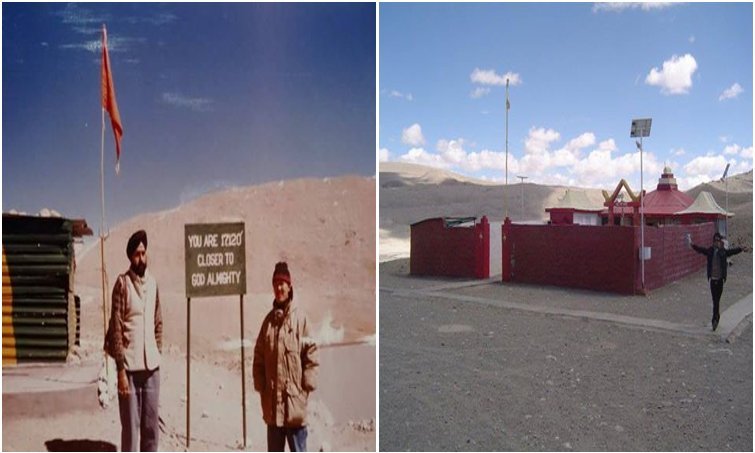 |
| (Left)Hindu flag and (Right) Construction converted to Buddhist structure. Nishan sahib flag removed |
In March 2001, Sardar Harbhajan Singh Setia and 14 other Sikhs reported that the religious sanctity of the historic Sikh Gurdwara constructed to commemorate Guru Nanak's visit has been changed to a Sarva Dharma Mandir and idols have been placed inside the sanctum sanctorum along with Guru Granth Sahib earlier installed in 1987. [19]
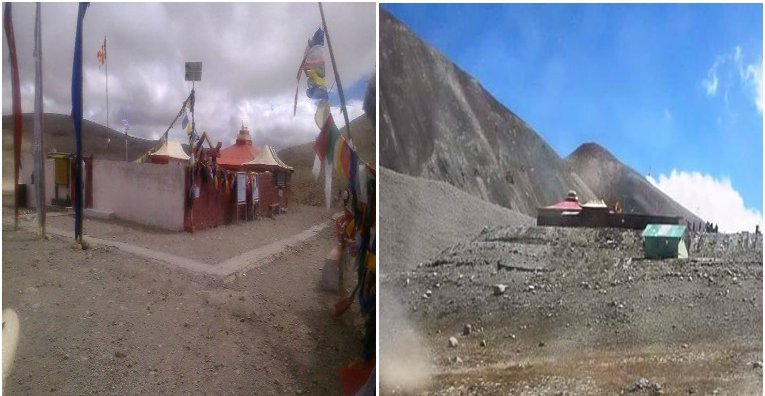 |
| (Left) Buddhist flag on Nishan sahib and (Right) All flags removed due to objections |
Later in 2007 onwards Lepcha Boddhis managed to get the control into civil hands and changed it into a Boddhi complex. Nishan sahib was removed in 2007 which was then replaced by Boddhi flag. Seeing pressure from devotees, no flag was displayed later.
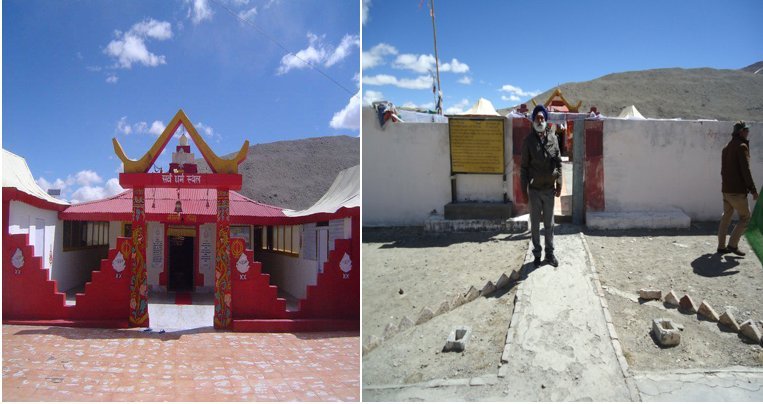 |
| (Left) Total structure converted to Buddhist one (Right) New board showing Padmasambha who performed miracle |
The new board displayed probably after 2011 and not in 2001 as is shown on the board which moved Guru Nanak's name and included Padmsambhava's name.
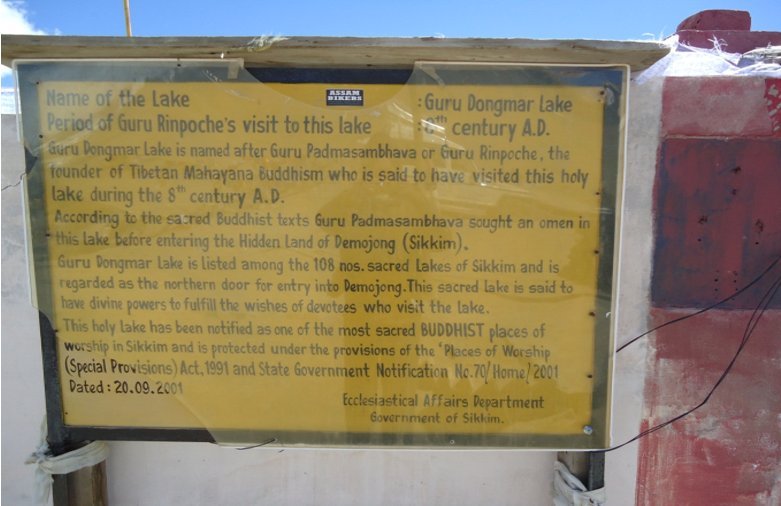 |
| Board showing Gurupadma sambhva and not Guru Nanak as the architect of unfrozen water |
The details of Guru Nanak's visit to Gurudongmar was written on a board. Now this board has been replaced by a new board showing that it was Guru Padmasambhva who broke the ice with stick (not Guru Nanak).
The Nishan Sahib flag too has been removed. Sri Guru Granth Sahib is kept packed in a Palki in a room with some Buddhist and Hindus idols/paintings duly displayed along with.
The team found no Parkash or Sukhasan or prayers as per rehat maryada. People entered even bare-headed. Smoking etc. is not banned. Gurdwara's independent identity and sanctity do not exist anymore...
To be continued
